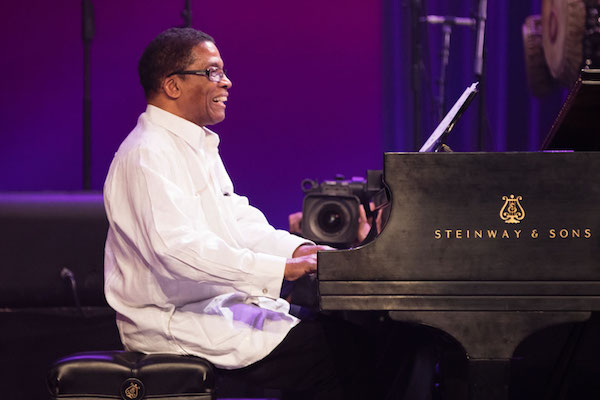Apr 2, 2024 12:59 PM
Saxophonist, Sonic Explorer Casey Benjamin Dies at 45
Casey Benjamin, the alto saxophonist, vocalist, keyboardist and producer who stamped his distinctive sounds on the…

Herbie Hancock, seen here at the 2017 International Jazz Day Global Concert in Havana, Cuba, performed in Atlanta on Oct. 17.
(Photo: jazzday.org/Thelonious Monk Institute of Jazz)At 77, multiple Grammy winner, NEA Jazz Master and musical ambassador Herbie Hancock refuses to become a legacy act. After a long career in music—as both jazz luminary and as a successful “crossover” collaborator with a host of pop artists—Hancock could simply show up for a performance, run though cherished melodies for an hour-and-a-half and move on to the next city.
But on Oct. 17 at Atlanta’s Symphony Hall, during a fundraising performance for local jazz station 91.9 FM–WCLK, Hancock brought an array of keyboards and synthesizers, a drum kit large enough for an arena rock show and a firm determination to create new material from old melodies and chord changes.
His band of bassist James Genus, drummer Vinne Colaiuta and multi-instrumentalist Terrace Martin (who is producing Hancock’s next album) is a cohesive, tight-knit group of musicians who carefully dispatch Hancock’s layered sonic ideas. Each musician excelled during solo turns. Hancock the accompanist knows how to push musicians, casting a wide harmonic net on piano and keyboard, giving soloists enough room to explore. While Genus created breathtaking solos with his limited solo turns, Martin benefited the most from this harmonic benevolence.
On keyboard, alto saxophone and vocals, Martin was by far the busiest of Hancock’s assembled team. On alto, Martin has a bright sound with an edge of grit that’s pointed enough to cut through layers upon layers of electronics. He’s also careful to craft and shape phrases even in the midst of loud, rock-fueled musical passages. During some solos, he would play as if biting off small chunks of notes, chewing on the ideas and slowly expanding his phrases, staying with these concepts until he was suddenly leaping up to the top of his range in a blur of multiphonics and high-velocity runs.
The quartet performed a handful of tunes—“Chameleon,” “Cantaloupe Island,” “Actual Proof” among them—throughout the night, but the actual melodies, and sometimes even the songs’ structures, didn’t seem that important to Hancock. The night was all about creating different musical textures, switching between keyboard to piano to keytar in the same tune to present different feelings. As he stacked these layers, Hancock worked as a painter, saturating the landscape of each song with kaleidoscopic colors.
The foundational components of these tunes are the same, and the warm light of nostalgia shone through in the majority of these works. But sonically, each tune seemed an of-the-moment creation, regardless of the song title. This reliance on creating something new each night from old tunes makes sense upon viewing the uniform, unwavering set lists for previous concerts on the same tour.
“Come Running To Me” shed its disco-lite vibes and, through heavily processed vocals, Hancock and Martin wove robotic-sounding harmonies that bent and wiggled like the notes on Hancock’s keyboards. While an entire evening of processed vocals would certainly have been grating, the brief introduction to a new interpretation of Hancock’s music worked well.
Hancock in as an avuncular septuagenarian on stage, regaling the audience with jokes and small talk the way a distant older relative might engage in Thanksgiving-table conversation. This endearing stage presence humanizes the oft-lionized Hancock, adding yet another dimension to his legacy.
Tuesday proved that Hancock has continued to hear and see his musical oeuvre in new ways. His music is much more than just playing classic jazz standards on electronics, adding in new musical elements just because he can. With every note, Hancock is finding ways to make his musical history live and breathe. DB

Benjamin possessed a fluid, round sound on the alto saxophone, and he was often most recognizable by the layers of electronic effects that he put onto the instrument.
Apr 2, 2024 12:59 PM
Casey Benjamin, the alto saxophonist, vocalist, keyboardist and producer who stamped his distinctive sounds on the…

“He’s constructing intelligent musical sentences that connect seamlessly, which is the most important part of linear playing,” Charles McPherson said of alto saxophonist Sonny Red.
Feb 27, 2024 1:40 PM
“I might not have felt this way 30 to 40 years ago, but I’ve reached a point where I can hear value in what people…

Albert “Tootie” Heath (1935–2024) followed in the tradition of drummer Kenny Clarke, his idol.
Apr 5, 2024 10:28 AM
Albert “Tootie” Heath, a drummer of impeccable taste and time who was the youngest of three jazz-legend brothers…

“Both of us are quite grounded in the craft, the tradition and the harmonic sense,” Rosenwinkel said of his experience playing with Allen. “Yet I felt we shared something mystical as well.”
Mar 12, 2024 11:42 AM
“There are a few musicians you hear where, as somebody once said, the molecules in the room change. Geri was one of…

Henry Threadgill performs with Zooid at Big Ears in Knoxville, Tennessee.
Apr 9, 2024 11:30 AM
Big Ears, the annual four-day music celebration that first took place in 2009 in Knoxville, Tennessee, could well be…